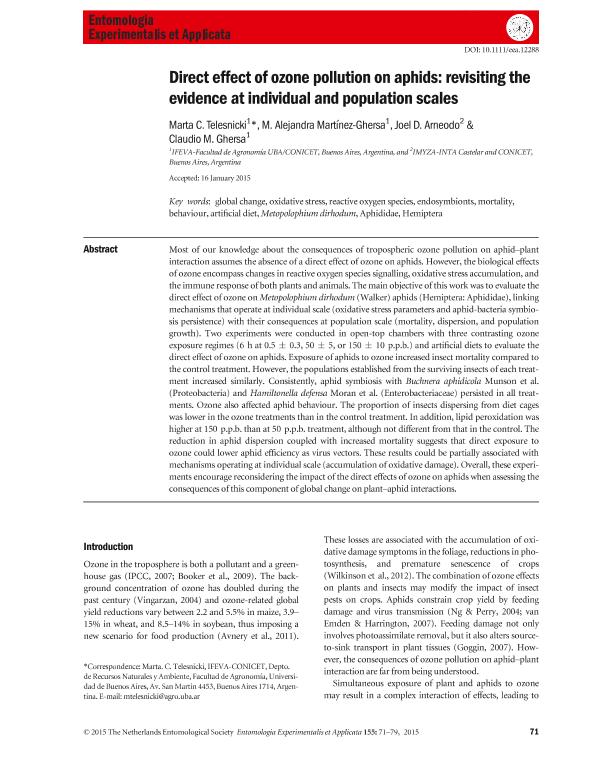Mostrar el registro sencillo del ítem
dc.contributor.author
Telesnicki, Marta Cecilia

dc.contributor.author
Martinez-Ghersa, Maria Alejandra

dc.contributor.author
Arneodo Larochette, Joel Demián

dc.contributor.author
Ghersa, Claudio Marco

dc.date.available
2017-06-05T19:10:17Z
dc.date.issued
2015-04
dc.identifier.citation
Telesnicki, Marta Cecilia; Martinez-Ghersa, Maria Alejandra; Arneodo Larochette, Joel Demián; Ghersa, Claudio Marco; Direct effect of ozone pollution on aphids: Revisiting the evidence at individual and population scales; Wiley Blackwell Publishing, Inc; Entomologia Experimentalis et Applicata; 155; 1; 4-2015; 71-79
dc.identifier.issn
0013-8703
dc.identifier.uri
http://hdl.handle.net/11336/17513
dc.description.abstract
Most of our knowledge about the consequences of tropospheric ozone pollution on aphid-plant interaction assumes the absence of a direct effect of ozone on aphids. However, the biological effects of ozone encompass changes in reactive oxygen species signalling, oxidative stress accumulation, and the immune response of both plants and animals. The main objective of this work was to evaluate the direct effect of ozone on Metopolophium dirhodum (Walker) aphids (Hemiptera: Aphididae), linking mechanisms that operate at individual scale (oxidative stress parameters and aphid-bacteria symbiosis persistence) with their consequences at population scale (mortality, dispersion, and population growth). Two experiments were conducted in open-top chambers with three contrasting ozone exposure regimes (6 h at 0.5 ± 0.3, 50 ± 5, or 150 ± 10 p.p.b.) and artificial diets to evaluate the direct effect of ozone on aphids. Exposure of aphids to ozone increased insect mortality compared to the control treatment. However, the populations established from the surviving insects of each treatment increased similarly. Consistently, aphid symbiosis with Buchnera aphidicola Munson et al. (Proteobacteria) and Hamiltonella defensa Moran et al. (Enterobacteriaceae) persisted in all treatments. Ozone also affected aphid behaviour. The proportion of insects dispersing from diet cages was lower in the ozone treatments than in the control treatment. In addition, lipid peroxidation was higher at 150 p.p.b. than at 50 p.p.b. treatment, although not different from that in the control. The reduction in aphid dispersion coupled with increased mortality suggests that direct exposure to ozone could lower aphid efficiency as virus vectors. These results could be partially associated with mechanisms operating at individual scale (accumulation of oxidative damage). Overall, these experiments encourage reconsidering the impact of the direct effects of ozone on aphids when assessing the consequences of this component of global change on plant-aphid interactions.
dc.format
application/pdf
dc.language.iso
eng
dc.publisher
Wiley Blackwell Publishing, Inc

dc.rights
info:eu-repo/semantics/openAccess
dc.rights.uri
https://creativecommons.org/licenses/by-nc-sa/2.5/ar/
dc.subject
METOPOLOPHIUM DIRHODUM
dc.subject
REACTIVE OXYGEN SPECIES
dc.subject
APHIDIDAE
dc.subject
ARTIFICIAL DIET
dc.subject
BEHAVIOUR
dc.subject
ENDOSYMBIONTS
dc.subject
GLOBAL CHANGE
dc.subject
HEMIPTERA
dc.subject
MORTALITY
dc.subject
OXIDATIVE STRESS
dc.subject.classification
Agricultura

dc.subject.classification
Agricultura, Silvicultura y Pesca

dc.subject.classification
CIENCIAS AGRÍCOLAS

dc.title
Direct effect of ozone pollution on aphids: Revisiting the evidence at individual and population scales
dc.type
info:eu-repo/semantics/article
dc.type
info:ar-repo/semantics/artículo
dc.type
info:eu-repo/semantics/publishedVersion
dc.date.updated
2017-06-02T17:32:29Z
dc.journal.volume
155
dc.journal.number
1
dc.journal.pagination
71-79
dc.journal.pais
Reino Unido

dc.journal.ciudad
Londres
dc.description.fil
Fil: Telesnicki, Marta Cecilia. Consejo Nacional de Investigaciones Científicas y Técnicas. Oficina de Coordinación Administrativa Parque Centenario. Instituto de Investigaciones Fisiológicas y Ecológicas Vinculadas a la Agricultura. Universidad de Buenos Aires. Facultad de Agronomía. Instituto de Investigaciones Fisiológicas y Ecológicas Vinculadas a la Agricultura; Argentina
dc.description.fil
Fil: Martinez-Ghersa, Maria Alejandra. Consejo Nacional de Investigaciones Científicas y Técnicas. Oficina de Coordinación Administrativa Parque Centenario. Instituto de Investigaciones Fisiológicas y Ecológicas Vinculadas a la Agricultura. Universidad de Buenos Aires. Facultad de Agronomía. Instituto de Investigaciones Fisiológicas y Ecológicas Vinculadas a la Agricultura; Argentina
dc.description.fil
Fil: Arneodo Larochette, Joel Demián. Instituto Nacional de Tecnología Agropecuaria. Centro de Investigación En Ciencias Veterinarias y Agronomicas. Instituto de Microbiología y Zoología Agrícola; Argentina. Consejo Nacional de Investigaciones Científicas y Técnicas; Argentina
dc.description.fil
Fil: Ghersa, Claudio Marco. Consejo Nacional de Investigaciones Científicas y Técnicas. Oficina de Coordinación Administrativa Parque Centenario. Instituto de Investigaciones Fisiológicas y Ecológicas Vinculadas a la Agricultura. Universidad de Buenos Aires. Facultad de Agronomía. Instituto de Investigaciones Fisiológicas y Ecológicas Vinculadas a la Agricultura; Argentina
dc.journal.title
Entomologia Experimentalis et Applicata

dc.relation.alternativeid
info:eu-repo/semantics/altIdentifier/doi/http://dx.doi.org/10.1111/eea.12288
dc.relation.alternativeid
info:eu-repo/semantics/altIdentifier/url/http://onlinelibrary.wiley.com/doi/10.1111/eea.12288/abstract
Archivos asociados
